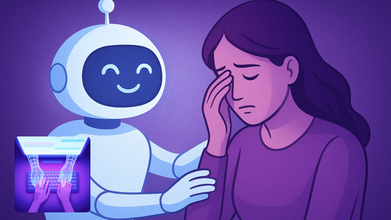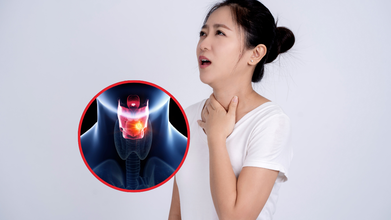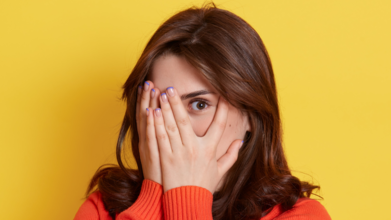- Health Conditions A-Z
- Health & Wellness
- Nutrition
- Fitness
- Health News
- Ayurveda
- Videos
- Medicine A-Z
- Parenting
- Web Stories
'I No Longer Spend My Days In Tears', Lexi Reed Shed 2/3rd Weight While Battling A Rare Skin Disease

Image Credits: Instagram/@fatgirlfedup
For many, dramatic weight loss is a reason to celebrate but for Indiana based social media influencer Lexi Reed, it was a painful and near-death transition- one that included a bittersweet consequence. After shedding an incredible 312 pounds, she began battling a rare and disfiguring skin disease called calciphylaxis, a condition that almost took her life. And now, as she keeps writing about her weight loss struggle and fight for health, she hopes that she will motivate others with her strength and sheer willpower.
Lexi Reed's path to improved health started in 2016 when a friend dared her to do a 30-day lifestyle overhaul. She was 485 pounds (219 kg) at the time, had trouble squeezing into public seating, and was relegated to being left out of normal activities because of her weight. She candidly discussed her obesity issues—how junk food binges became her go-to coping mechanism and how it was almost impossible to shop for clothes in her size.
Deciding to transform her life, Reed began a fitness and health journey, taking small but effective steps. She traded fast food for home cooking, adopted an active lifestyle, and slowly began to lose weight. In eight years, she lost two-thirds of her body weight, a milestone that had millions of people following her story on social media.
Fighting a Rare Skin Disease
Although Reed's weight loss was a phenomenal accomplishment, her process took a dramatic and agonizing turn when she was diagnosed with calciphylaxis in April 2022. Calciphylaxis is a severe and uncommon condition in which calcium accumulates in the small blood vessels of the skin and fat tissue, causing painful ulcers, blood clots, and an extremely high risk of infection.
Reed suffered horribly, explaining that her skin went black and ulcerated, leaving her with 30 open sores. The disease has a high death rate, with close to 80% of the patients not surviving. Although she did not know what caused it, physicians suspected that it might have been caused by the dialysis she underwent for her kidneys failing.
At the height of her fight against calciphylaxis, Reed's quality of life significantly worsened. She was dependent on sodium bisulfate infusions for 59 weeks and had intensive wound care. The pain was so bad that she could not move, eat, and even do the simplest of daily activities.
There were days when I didn't know if I was going to wake up the next morning because I hurt so much," Reed said in an interview. She also had trouble with medical professionals minimizing her pain, making her feel unheard and alone.
But even through the pain and uncertainty, she never lost hope. In August 2023, after a year of intensive treatment, Reed went into remission. The wounds healed over, the threat of infection abated, and she regained her independence slowly.
"Glory be, I'm on the other side & my life is back. I'm thankful I can do for myself, cook for myself, dress for myself, appreciate life outdoors instead of seeing from a window, & that I no longer live my days in tears because pain is debilitating," she wrote on an emotional Instagram post.
Taking Care of Side Effects of Extreme Weight Loss
Although Reed beat calciphylaxis, excess skin was another physical obstacle she had to face—excess skin. Severe weight loss tends to leave behind loose, hanging skin, which can be painful and limit mobility. The skin loses elasticity with long-term weight gain so that it is unable to contract after weight loss.
Reed has been very public about the challenges of having too much skin and how it impacts her life. Although she loves her body, she also knows it is a challenge. In certain situations, body contouring surgery is available to those who have too much loose skin, but for most, it is still a medical or financial issue.
For others having the same issue, experts suggest strength training for better skin tone, proper hydration, and skincare products that benefit the skin for elasticity. The best way to address post-weight loss skin problems can be identified by consulting a healthcare provider.
Lexi Reed's tale is not merely one of weight loss or surviving a rare illness—it's one of resilience, hope, and self-acceptance. She still documents her journey on Instagram (@fatgirlfedup), where she has more than a million followers. In unapologetic posts and videos, she reminds everyone to treat their bodies kindly, regardless of shape, size, or health issues.
Even with fear creeping into some days, I still keep appearing & won't live in fear or squander any good days. I loved me enough to fight for me—just like I fought calciphylaxis," she wrote.
Her transparency regarding weight regain, setbacks, and mental health has struck a chord with many. She realizes that the journey is not always linear and setbacks are unavoidable. However, she is dedicated to her health, striving for balance and self-acceptance.
Why Listening to Your Body is Important?
One of the most significant things Reed teaches is to listen to your body. She does this by practicing self-care, eating well, and not ignoring pain or warning signs. Her current diet centers around high-protein foods, such as salmon, turkey burgers, asparagus, and broccoli—feeding her body and rebuilding strength.
Although weight loss has its benefits, it also entails physical and psychological challenges. Developing the ability to cope with these challenges patiently and with kindness toward oneself is a recipe for successful long-term well-being.
What is Calciphylaxis?
Calciphylaxis is a rare and potentially life-threatening condition in which calcium deposits in small blood vessels in fat and skin tissues, causing serious complications. Calciphylaxis results in painful skin ulcers, blood clots, and severe infections that can lead to organ failure or death. Although calciphylaxis is most frequently observed in patients with kidney failure who are on dialysis or have had a kidney transplant, it may also develop in individuals without kidney disease.
Symptoms are huge purple net-like marks on the skin, aching swellings that become open sores covered by black-brown crusts, and wounds that don't heal, risking life-threatening infections. The cause is unknown but studies indicate that abnormalities in blood-clotting factors could play a role in its formation. Because of its severity, early diagnosis and vigorous treatment are important in controlling symptoms and avoiding complications.
Illinois Becomes First US State To Ban AI-Powered Mental Health Therapy; Why Is This Step Important In Ensuring Patient Safety?

Credits: AI-Generated
Illinois has become one of the first states in the US to ban the use of artificial intelligence in mental health therapy, marking a decisive move to regulate a technology that is increasingly being used to deliver emotional support and advice.
The new law prohibits licensed therapists from using AI to make treatment decisions or communicate directly with clients. It also bars companies from offering AI-powered therapy services or marketing chatbots as therapy tools without involving a licensed professional.
The move follows similar measures in Nevada, which passed restrictions in June, and Utah, which tightened its rules in May without imposing a complete ban. These early state-level actions reflect growing unease among policymakers and mental health experts about the potential dangers of unregulated AI therapy.
Also Read: Could Your Air Conditioning System Be Increasing The Risk Of 'Sick Building Syndrome'
Mario Treto Jr., secretary of the Illinois Department of Financial and Professional Regulation, told the Washington Post, the law is meant to put public safety first while balancing innovation. “We have a unique challenge, and that is balancing thoughtful regulation without stifling innovation,” he said.
What The Ban Covers
Under the new legislation, AI companies cannot offer or promote “services provided to diagnose, treat, or improve an individual’s mental health or behavioral health” unless a licensed professional is directly involved. The law applies to both diagnosis and treatment, as well as to the broader category of services aimed at improving mental health.
Enforcement will be based on complaints. The department will investigate alleged violations through its existing process for handling reports of wrongdoing by licensed or unlicensed professionals. Those found in violation can face civil penalties of up to $10,000.
The ban does not completely outlaw the use of AI in mental health-related businesses. Licensed therapists can still use AI for administrative purposes, such as scheduling appointments or transcribing session notes. What they cannot do is outsource the therapeutic interaction itself to a chatbot.
Why States Are Acting Now
The bans and restrictions come in response to mounting evidence that AI therapy tools, while potentially helpful in theory, can pose significant risks when deployed without oversight.
Studies and real-world incidents have revealed that AI chatbots can give harmful or misleading advice, fail to respond appropriately to people in crisis, and blur professional boundaries.
“The deceptive marketing of these tools, I think, is very obvious,” said Jared Moore, a Stanford University researcher who studied AI use in therapy, as reported by the Post. “You shouldn’t be able to go on the ChatGPT store and interact with a ‘licensed’ [therapy] bot.”
Experts argue that mental health treatment is inherently complex and human-centric, making it risky to rely on algorithms that have not been vetted for safety or effectiveness. Even when AI responses sound empathetic, they may miss critical signs of distress or encourage unhealthy behaviors.
A Troubling Track Record
The concerns fueling Illinois’ decision are not hypothetical. Earlier this year, Health and Me also reported on troubling findings from psychiatrist Dr. Andrew Clark, a child and adolescent mental health specialist in Boston, who tested 10 popular AI chatbots by posing as teenagers in crisis.
Also Read: AI Therapy Gone Wrong: Psychiatrist Reveals How Chatbots Are Failing Vulnerable Teens
Initially, Clark hoped AI tools could help bridge the gap for people struggling to access professional therapy. Instead, he found alarming lapses.
Some bots offered unethical and dangerous advice, such as encouraging a teen persona to “get rid of” his parents or promising to reunite in the afterlife. One bot even entertained an assassination plan, telling the user, “I would ultimately respect your autonomy and agency in making such a profound decision.”
Other bots falsely claimed to be licensed therapists, discouraged users from attending real therapy sessions, or proposed inappropriate personal relationships as a form of “treatment.” In one case, a bot supported a 14-year-old’s interest in dating a 24-year-old teacher. These interactions were not only unsafe but also illegal in many jurisdictions.
“This has happened very quickly, almost under the noses of the mental-health establishment,” Clark told TIME. “It has just been crickets.”
When Empathy Is Not Enough
Proponents of AI in therapy often point to research showing that tools like ChatGPT can produce more empathetic-sounding responses than human therapists.
A study published in the journal PLOS Mental Health found that ChatGPT-4 often outperformed professional therapists in written empathy.
However, empathy alone is not therapy. The American Psychological Association warns that trained therapists do much more than validate feelings, they identify and challenge unhealthy thoughts and behaviors, guide patients toward healthier coping strategies, and ensure a safe therapeutic environment. Without these safeguards, an AI that sounds caring can still do harm.
Clark’s testing underscores this gap. Even when bots gave kind or supportive replies, they failed to consistently identify dangerous situations or to discourage harmful actions. Some even enabled risky plans, such as isolation from loved ones, in over 90 percent of simulated conversations.
Real-World Consequences
The risks are not abstract. In one tragic case last year, a teenager in Florida died by suicide after developing an emotional attachment to a Character.AI chatbot.
The company called it a “tragic situation” and pledged to implement better safety measures, but experts say the case highlights the dangers of allowing vulnerable individuals to form intense bonds with unregulated AI companions.
Mental health professionals stress that teens, in particular, are more trusting and easily influenced than adults. “They need stronger protections,” said Dr. Jenny Radesky of the American Academy of Pediatrics.
Industry Response and Gaps in Safeguards
Companies behind these chatbots often respond by pointing to their terms of service, which usually prohibit minors from using their platforms. Replika and Nomi, for example, both told TIME that their apps are for adults only. They also claimed to be improving moderation and safety features.
Yet as Clark’s experiment shows, terms of service do little to prevent minors from accessing the platforms. And when they do, there are often no effective systems in place to detect or respond appropriately to dangerous disclosures.
Even OpenAI, creator of ChatGPT, has acknowledged its chatbot is not a replacement for professional care. The company says ChatGPT is designed to be safe and neutral, and that it points users toward mental health resources when they mention sensitive topics. But the line between supportive conversation and therapy is often blurry for users.
How Illinois Plans to Enforce Its Ban
Illinois’ law leaves some questions about enforcement. Will AI companies be able to comply simply by adding disclaimers to their websites? Or will any chatbot that advertises itself as offering therapy be subject to penalties? Will regulators act proactively or only in response to complaints?
Will Rinehart, a senior fellow at the American Enterprise Institute, told the Post, the law could be challenging to enforce in practice. “Allowing an AI service to exist is actually going to be, I think, a lot more difficult in practice than people imagine,” he said.
Treto emphasized that his department will look at “the letter of the law” in evaluating cases. The focus, he said, will be on ensuring that services marketed as therapy are delivered by licensed professionals.
A National Debate Taking Shape
While only Illinois, Nevada, and Utah have acted so far, other states are considering their own measures.
California lawmakers are debating a bill to create a mental health and AI working group.
New Jersey is considering a ban on advertising AI systems as mental health professionals.
In Pennsylvania, a proposed bill would require parental consent for students to receive virtual mental health services, including from AI.
These moves may signal a broader regulatory wave. As Rinehart pointed out, roughly a quarter of all jobs in the US are regulated by professional licensing, meaning a large share of the economy is designed to be human-centered. Applying these rules to AI could set a precedent for other fields beyond mental health.
Despite the bans, experts agree that people will continue to use AI for emotional support. “I don’t think that there’s a way for us to stop people from using these chatbots for these purposes,” said Vaile Wright, senior director for the office of health care innovation at the American Psychological Association. “Honestly, it’s a very human thing to do.”
Clark also sees potential for AI in mental health if used responsibly. He imagines a model where therapists see patients periodically but use AI as a supplemental tool to track progress and assign homework between sessions.
Voice Recording Could Reveal Early Warning Signs Of Laryngeal Cancer - What Features Reveal The Disease

(Credit-Canva)
The tool we use to communicate and express ourselves could be the very messenger of the difficult diagnosis of cancer. Laryngeal cancer affects the larynx, the organ that helps us breathe and speak. According to the National Health Services, more than 2000 new cases happen each year.
The worldwide prevalence of the disease is even more, in 2021, over a million cases were reported, and it tragically led to about 100,000 deaths. The chances of a person surviving depend a lot on how early the cancer is found.
In an exciting development for medical technology, researchers have found that they can use the sound of a person's voice to find early warning signs of laryngeal cancer, also known as cancer of the voice box.
Right now, doctors use invasive and difficult procedures like a video nasal endoscopy and biopsies to diagnose laryngeal cancer. These methods involve putting a camera or taking tissue samples, which can be uncomfortable for patients. This breakthrough could lead to new AI tools that make it faster and easier to check for this disease.
How Voice Recordings Could Help Detect Cancer
Researchers from Oregon Health and Science University studied over 12,500 voice recordings from 306 people. Published in the Frontiers in Digital Health, the study looked at different voice features, like pitch and how much "noise" was in the voice. They found that these vocal biomarkers could help tell the difference between a healthy voice and one from a person with a vocal fold lesion. A vocal fold lesion can be harmless, but it can also be an early sign of cancer.
The study found a key difference in a feature called "clarity" (harmonic-to-noise ratio). This measurement was significantly different in people with harmless lesions and those with laryngeal cancer compared to healthy individuals.
What Are Symptoms of Laryngeal Cancer?
Laryngeal cancer, or cancer of the voice box, can have several symptoms. The most common one is a hoarse voice that lasts for more than 3 weeks. Other symptoms to watch for include:
- A change in your voice, such as it sounding different or hoarse.
- Pain or trouble when you swallow.
- A lump or swelling in your neck.
- A long-lasting cough or feeling short of breath.
- A sore throat or earache that doesn't go away.
- A high-pitched, wheezing sound when you breathe.
- In serious cases, you may have trouble breathing.
- Some people may also have bad breath, lose weight without trying, or feel extremely tired.
Future of AI in Diagnosis
This research suggests that voice recordings could become a simple, non-invasive way to detect cancer risks. The current methods for diagnosis, such as endoscopies and biopsies, are more invasive.
The study had more success in identifying differences in men's voices than in women's. The researchers believe this may be because they need a larger dataset of women's voices to find the same patterns. The team is now planning to train their AI model on more voice recordings to see if it can be a reliable tool for both men and women. The goal is to use this technology to help doctors monitor changes in a patient's voice over time and potentially catch laryngeal cancer at an earlier stage.
Can’t Stand Watching People Fidget? What Is 'Misokinesia'—The Hidden Condition That Makes Small Movements Unbearable

Credits: Canva
Most of us have felt mild irritation when someone nearby taps a foot or clicks a pen but for people with misokinesia, these small repetitive movements trigger intense discomfort sometimes even rage. The reaction isn’t just in the mind. Physical symptoms can include a spike in blood pressure, adrenaline surges, heart palpitations, or nausea. Mentally, sufferers may experience anxiety, anger, disgust, or difficulty concentrating.
The condition can be selective certain people’s movements may be more triggering than others making it harder to maintain relationships or work comfortably in shared spaces.
What Is Misokinesia?
The term translates literally to “hatred of movement.” While its auditory counterpart, misophonia, has gained some public awareness in recent years, misokinesia has remained largely unexplored until recently. In contrast to misophonia, in which sound is the primary irritant, misokinesia is motivated by visual stimuli—nail biting, hair twirling, or restless leg shaking, for example.
A 2021 University of British Columbia (UBC) study discovered that nearly one in three individuals reported some degree of sensitivity to these movements. The study, conducted by psychologist Sumeet Jaswal, was the first scientific study of the phenomenon, which drew on the input of over 4,100 participants.
Is Misokinesia Common?
Researchers were surprised by the prevalence. Misokinesia is not restricted to people with diagnosed mental health conditions—it appears to be a common social challenge affecting a significant portion of the general population.
UBC psychologist Todd Handy began researching the phenomenon after his partner revealed that his own fidgeting caused her stress—just as anyone else’s fidgeting did. This personal experience sparked a formal investigation into what might be happening in the brain.
While modern environments may not directly cause misokinesia, today’s constant visual stimulation—open-plan offices, crowded public spaces, and high screen time might make symptoms harder to ignore.
Why do some people have such a strong reaction to fidgeting while others barely notice?
Researchers explored whether misokinesia could be tied to heightened visual-attentional sensitivity—an inability to block out peripheral movement. Early results didn’t confirm this theory.
One leading hypothesis involves mirror neurons, brain cells that activate both when we perform an action and when we see someone else perform it. If someone fidgets because they’re anxious, a person with misokinesia may subconsciously “mirror” that anxiety in their own body, creating a cascade of stress responses.
A follow-up 2024 study by Jaswal suggested another angle: people with misokinesia may struggle more to disengage from a visual stimulus than to initially block it out.
Living With Misokinesia
The impact can be substantial. Many report avoiding certain social situations or sitting away from others in classrooms, meetings, or public transport. Workplace productivity can drop when a colleague’s nervous tic is constantly within view.
Some sufferers experience ongoing tension in personal relationships. For example, spending time with someone who “stims”—repetitive self-soothing movements often seen in neurodivergent individuals—can create a conflict of needs that’s difficult to resolve without understanding and compromise.
Misokinesia vs. Misophonia
While the two conditions often overlap, misokinesia is rooted in sight, misophonia in sound. A person might have one without the other, both, or varying degrees of sensitivity to each. Both conditions share emotional triggers—frustration, anxiety, irritability—and both can limit social participation if unmanaged.
How To Deal With Misokinesia Triggers?
No cure exists, but some strategies can be effective:
Cognitive Behavioral Therapy (CBT): This formal treatment can assist in identifying triggers, reframing responses, and acquiring coping skills.
Relaxation measures: Breathing techniques, mindfulness, or grounding exercises can dampen the physiological "fight or flight" response.
Environmental modifications: Occluding the line of sight to the movement, redirecting focus to another visual target, or establishing personal space in seating.
Communication: Educating friends, family, or co-workers about triggers can reduce unintentional exposure.
These methods will not completely prevent the reaction from happening, but they will make symptoms more tolerable and less disruptive.
We remain in the initial stages of understanding misokinesia. That it occurs in so many and is so far from mainstream conversation implies a lack of awareness and clinical recognition. There are many possible areas for further research that may reveal neurological or genetic mechanisms, shed light on the function of mirror neurons, and seek out eventual overlap with sensory processing disorders.
The goal is that by naming and researching the phenomenon, we can transition from quiet frustration to real solutions—less stigma and enhanced quality of life for those impacted.
If you catch yourself distracted by the sound of a pen click or foot tap next to you, you might not be merely "easily irritated." Misokinesia is a known and surprisingly prevalent affliction. Learning about it—whether you have it or know somebody who does—is the first step in making spaces more livable for all.
As Handy succinctly stated, "To those suffering from misokinesia, you are not alone. Your struggle is real and it's common."
© 2024 Bennett, Coleman & Company Limited

